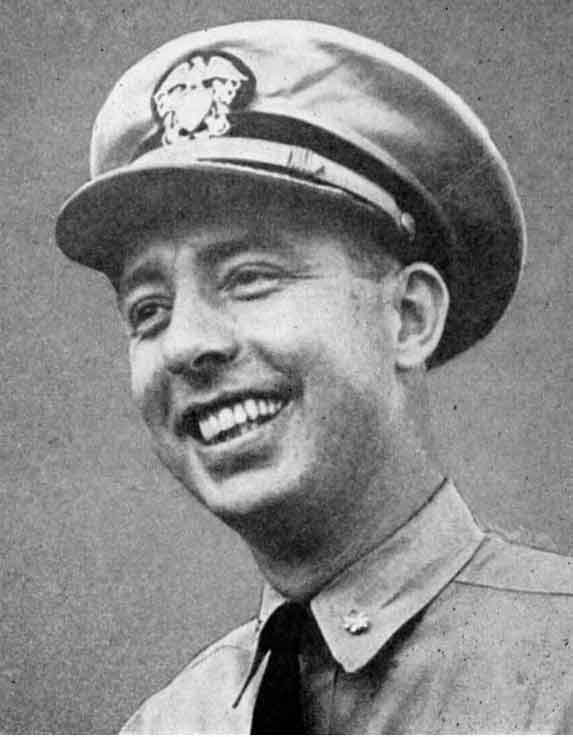
In the early years of World War II, Lawson “Red” Ramage served aboard USS Grenadine (SS-210) and commanded the USS Trout (SS-202). While aboard Trout, Ramage had damaged the Japanese light-carrier Taiyo in 1942 and received the Navy Cross for this action.
CDR. Ramage took command of the Balao-class submarine USS Parche (SS-384) in May of 1943. In its first war patrol, the Parche was credited with two sinkings for 11,700 tons. But it was the Parche’s second war patrol that would bring it everlasting fame.
Joining two other submarines – USS Steelhead (SS-280) and USS Hammerhead (SS-364) – in the Luzon Strait, the Parche sought in vain for enemy shipping to attack. Finally, on July 30, 1944, the Hammerhead found a large convoy and radioed the coordinates to the two other members of its wolf pack. Early on the morning of July 31, 1944, Ramage maneuvered the Parche towards the convoy. While the Parche maneuvered to gain an attack position, the convoy changed course and began to bear down directly upon Ramage’s surfaced sub.
Rather than seek refuge in a deep dive, Ramage decided to engage in a close-quarter surface battle with the large Japanese convoy. Passing by the two escorting destroyers, Ramage cleared the bridge of everyone except himself and one sailor to man the deck gun. The Parche let loose three torpedoes from its bow tubes that hit one freighter and two tankers in the convoy. Now alerted by the explosions, the Japanese ships began to furiously maneuver, while firing machine guns and cannon fire towards their assailant.

Amidst all the confusion, the Parche had to deftly maneuver itself to avoid enemy ships and to line up new targets. Slamming the rudder hard to the right, Parche narrowly avoided being rammed by one of the large freighters – one missing the vulnerable sub by just 50 feet. This emergency maneuver placed Parche in the direct path of an oncoming cargo ship, the Manko Maru. With few viable choices available, Ramage ordered three “down the throat” torpedoes at the charging ship. While the first torpedo missed, the second two struck home and the Manko Maru went dead in the water. Ramage then came quickly about to line up his stern tubes for the coup de grace. Firing two more torpedoes that struck home, the Manko Maru went quickly to the bottom.
While the remaining Japanese ships continued to fire blindly into the night, Ramage could find no more targets and maneuvered out of the fight. In 46 minutes of wild, chaotic fighting, Ramage and the Parche had fired 19 torpedoes and had sunk four ships outright and was credited, along with Steelhead, with a partial sinking for a fifth.
Upon Parche’s return to Pearl Harbor, Commodore Merrill Comstock read Ramage’s report of this remarkable engagement and stated that “this was foolhardy, very dangerous and an undue risk…. But I guess it’s okay as long as it came out all right. You got away with it, but don’t do it again…”

Parche’s actions on July 31, 1944 would earn the submarine a Presidential Unit Citation and the Medal of Honor for its commander, “Red” Ramage. Ramage would receive his Medal of Honor on January 12, 1945 from President Roosevelt in the Oval Office.
After receiving the Medal of Honor, Ramage created a certificate for each member of the Parche’s crew. In that certificate, Ramage stated “…that the Medal of Honor was accepted from the President of the United States as the Nation’s tribute to a fighting ship and her courageous crew. He feels that every officer and man whose loyal cooperation and able assistance contributed to the success of the “Parche” has an equal share in this award which he holds in trust for you….”
Ramage was raised in Massachusetts and was a 1931 graduate of the United States Naval Academy. He passed away in Bethesda, Maryland in 1990. In his seven patrols during World War II, Ramage would be credited with 10 ships sunk (77,200 tons).
Learn More
- USS Parche and Commander “Red” Ramage’s Medal of Honor (US Navy)
- Video: Medal of Honor – Red Ramage (Submarine Force Museum)



